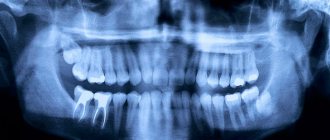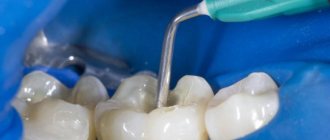Why is root canal retreatment prescribed and how to avoid it
Treatment of periodontitis does not always end with a solution to the problem, especially when it comes to interaction with an incompetent doctor. Sometimes the dental tissues become inflamed and this causes severe pain. In addition, inflammation is fraught with further complications, which are long and difficult to treat.
The reasons may be different: unprofessional dental care, poor-quality fillings, poorly cleaned root cavities. In any case, the first thing to do when inflammation occurs is to make an appointment with a doctor.
When can canal retreatment help?
- Inflammatory process or traumatic damage to sensitive soft tissue (pulp) after filling tooth canals
- Deeper spread of infection through the root apex
- Pain that persists for a long time after dental filling
- Detection of a focus of latent inflammation on an x-ray
- A fragment of an instrument remaining in the treated canal
- Prosthetics planning. Before installing a prosthetic structure, the doctor must minimize the risk of developing inflammation under it. Retreatment of tooth canals before prosthetics helps prevent the formation of cysts, suppuration and pulpitis, as well as deep penetration of infection into the surrounding tissues.
Canal retreatment is a unique opportunity to save a tooth in situations that previously always ended in its removal.
Indications for retreatment
Additional therapy, of course, can be prescribed to you only after a thorough examination. The main indications, which are a strong argument for retreatment, include:
- a fragment of a medical instrument stuck in the canal;
- pain that still does not go away, although a week or more has passed since treatment;
- a canal that is not completely sealed - this is usually indicated by discomfort when eating;
- hidden inflammation shown in the picture;
- infection affecting the periodontal tissues.
Is it necessary to treat a tooth if it doesn’t hurt?
Sometimes re-treatment is required even if the patient does not feel any discomfort. For example, poor quality of work or filling material leads to the fact that one canal remains not completely closed. A chronic process develops, which the doctor detects on an x-ray. A chip, crack or complete loss of the filling is also a reason for infection. In these cases, retreatment should be carried out regardless of whether there is pain or not.
How is the procedure done?
Root canal retreatment consists of several stages:
- anesthesia is administered;
- open the tooth and remove the filling;
- open the dental canals and remove the filling material;
- perform an audit of channels;
- treat the entire length of the dental canals to completely eliminate the source of inflammation;
- the tooth canals are re-filled in accordance with the endodontic treatment protocol;
- restore the dental crown using fillings or prosthetics.
The most important stage of re-treatment is cleaning the canals from pathogenic microorganisms and remnants of the previous filling. It is produced mechanically using special equipment and attachments of various sizes and shapes. Medicinal treatment is also possible. But despite their high efficiency, mechanical and medicinal cleaning cannot guarantee one hundred percent destruction of the infection. Processing becomes difficult when the channels are highly branched and tortuosity. Therefore, transcanal ultraphonophoresis, intracanal electrophoresis, and depophoresis can be additionally used.
For repeated filling, antiseptics are added to filling materials. During the procedure, it is necessary to carefully monitor the high-quality filling of the canals so that the inflammatory process does not begin in the future.
What are the nuances of root canal retreatment?
Before performing the procedure, several preparatory steps are required:
- The channel is “opened” - a hole is drilled to access it.
- The material remaining from the previous filling is removed.
- The specialist examines the work area under high magnification so as not to miss structural features and minor defects.
After this, root canal retreatment is performed:
- Processing them with tools along the entire length
- If necessary, medications with anti-inflammatory effects can be used, which the doctor places under a temporary filling.
- After this, the canals are filled again with a filling compound, and the top is covered with a filling, dental inlay or artificial crown.
Teeth retreatment is carried out under a microscope, which allows the specialist to detect even tiny additional holes and not miss them during the treatment process. High-quality magnification helps the doctor work with pinpoint precision.
The technique has a serious advantage over other techniques because it preserves your own tooth, which works well and looks great for many years.
Indications and contraindications for root canal filling
Indications
- Painful symptoms, inflammatory processes and swelling of the gum tissue in a patient who some time ago underwent endodontic treatment;
- Insufficient quality of the filling is its depressurization or poor fit at the edges, which makes it difficult to remove food debris and provokes the development of a carious process;
- Inflammatory or infectious processes of the dental canals under the filling;
- The need for retreatment of root canals for pulpitis, periodontitis, cystic formation, granuloma;
- The need to install an intracanal pin;
- Violations of the previously performed root canal obturation technology.
Contraindications
- Serious damage to the periodontal tissues surrounding the unit, which is not an obstacle to saving the tooth;
- The unit is unsuitable for restoration;
- Impossibility of intervention on its closed part;
- Neoplasm of malignant etiology in the area of the affected unit;
- A purulent-necrotic process that affects bone tissue;
- General serious condition of the patient.
How much does the procedure cost?
This is a high-tech technique, as it involves treating teeth under a microscope using special equipment.
For the procedure of tooth canal retreatment, the cost depends on: the price of equipment and consumables, the technical complexity of the work, the number of roots in the tooth, etc. The total amount may also be affected by the price of the preliminary examination (X-ray) and preparatory procedures (professional oral hygiene).
But in any case, re-treatment of tooth canals under a microscope will cost less than implantation and prosthetics, the treatment process will take less time, and the result will be physiological.
Services and prices
Dental treatment for people is always associated with unpleasant associations - despite the fact that modern dentistry has made this process almost painless. And if the question of retreatment is raised, then each of us tries to postpone the visit to the dentist under any convenient pretext. Meanwhile, retreatment of teeth is necessary in some cases, and the sooner this is done, the better.
Most often, according to the observations of specialists, there is a need to re-treat the canal. Why is it often impossible to do without repeated root canal treatment? We answer.
Why is tooth canal retreatment necessary?
Until relatively recently, domestic dentists did not have the necessary tools or appropriate medications to carry out root canal treatment at the proper level of quality. The work of an endodontist in terms of complexity, painstakingness and accuracy can be compared with the art of a microsurgeon, but, unfortunately, old burs and many other instruments made it possible to treat root canals exclusively “by touch.” In many situations, existing equipment did not allow the tooth to be completely cured - after all, the dental canal, at best, was half or two-thirds through. For this reason, over time, a cyst (granuloma) formed on the top of the tooth, the discovery of which, in fact, put an end to its future fate. It was impossible to treat the tooth, so the question of removal was immediately raised. Now the AYUS-dent clinic has modern high-tech equipment that will help preserve your teeth.
In addition to this, treating canals “by touch” risks missing them. Previously, for example, it was believed that in the central teeth there was one canal, and in the molars their number could reach three. However, thanks to modern research methods, it has been established that 5-6 canals may be present in molars. It is often impossible to see all the channels on an x-ray, since they can “overlap” each other. With a microscope, this problem is completely solvable.
A canal missed during treatment can become a source of constant discomfort and pain, as well as the cause of the formation of a hilar cyst. Therefore, root canal retreatment in this case is an urgent need.
Miracles of modern dentistry
If doctors have declared your tooth hopeless, do not rush to agree to have it removed: contact the AYUS-dent clinic. Modern techniques make it possible to preserve and treat teeth that just a couple of years ago were considered unviable and therefore had to be removed. Our doctors will be able to successfully treat teeth if there is even the slightest chance of their normal functioning.
The process of re-treatment of dental canals takes place in several stages.
— Opening (unsealing)
— Cleaning the canals to the very top, if necessary, using a microscope
— Elimination of the source of infection
— Retreatment of tooth canals
— Hermetic sealing
As a result of this complex and multi-stage procedure, the inflammatory process stops and the granuloma resolves. Even if there is little left of the crown of the tooth, it is worth fighting for its root: re-treatment of the canals allows you to preserve the root of the tooth, into which a pin is placed during prosthetics. This method of prosthetics allows you to avoid the use of a bridge structure and not affect the adjacent teeth (which in most cases are absolutely healthy). Thus, re-treating the canals of only one tooth actually saves two more.
Microscope or X-ray?
Many patients ask the question: which is better – a microscope or an x-ray? This formulation of the question is not entirely correct, but we will try to answer it.
The use of the microscope has made fundamental changes in the quality criteria of dental treatment. Modern practice - both treatment and re-treatment of teeth - is simply unthinkable without good magnification. Based on an X-ray alone, it is sometimes very difficult to draw a conclusion: whether it is possible to re-treat the canals of the teeth, or whether they need to be removed.
The initial canal treatment could be carried out using non-contrast filling materials - in this case, not all areas where canal retreatment is required will be visible on the image. In addition, we should not forget that X-ray irradiation is still irradiation, albeit in minimal doses. And in some cases, when dental treatment is an urgent need, X-ray examination may be contraindicated (for example, during pregnancy).
It has already been mentioned that the image obtained on an x-ray is planar, so one channel can overlap another, thereby closing it. A complete diagnostic picture, which requires retreatment of teeth, is only possible with several photographs of the tooth in different projections - which takes up precious time. In addition, the images do not show the presence of fluid in the canal, while re-treatment of the canals using a microscope makes it possible to detect it in a timely manner.
Treatment of canals under a microscope significantly expands the doctor’s capabilities: illumination and magnification leave no possibility of missing a canal or incomplete extraction of nerve tissue. In addition, by varying the degree of sharpness and illumination, it is possible to evaluate the directionality, branching and width of even the deepest canal with complex anatomy - which allows the canal to be treated with a high degree of quality.
Re-treatment of canals using a microscope allows the endodontist to carry out full root canal treatment even in such complex cases when it is necessary to extract nerve tissue from a tortuous, hard-to-reach and very thin canal. The use of a microscope made it possible to re-treat root canals in the least traumatic way: old material is removed from the dental canal, and healthy dentin is not damaged. But the prognosis for treatment is the more favorable, the greater the percentage of natural dental tissue that has been preserved.
So, if it is necessary to carry out high-quality re-treatment of the tooth canals, to exclude secondary caries and many other serious diseases, the endodontist needs to enlarge and have good lighting of the working space - and this is only possible with the help of a microscope. Therefore, we can say with confidence: the presence of a microscope in a dental clinic is one of the signs of its high level. For example, in Switzerland, about 80 percent of dental institutions work using this device. Retreatment of teeth using a microscope practically reduces to zero the risk of poor-quality canal treatment, secondary inflammation and infection of surrounding tissues.
The AYUS-dent clinic has the most modern equipment, with the help of which highly qualified doctors successfully solve the problem of re-treatment of root canals - as well as any other problems related to the health of your teeth.
Tired of suffering?
Do you want the treatment to take place without pain and in comfortable conditions?
Make an appointment!
Where to go?
Such a high-tech type of assistance, such as re-treatment of previously filled root canals, can only be offered by a few dental clinics in Moscow. And we are glad that ours is among them. The latest equipment and a team of experienced doctors who know advanced treatment methods help us provide modern services at a high level. The principle of our work: if a tooth can be saved, we need to use all methods to fight for it.
Preparation for the procedure
Before proceeding with canal retreatment, the dentist will evaluate:
- condition of the tooth;
- the possibility of high-quality tooth restoration;
- the importance of tooth preservation.
If the root canals are too narrow or difficult to navigate, endodontic surgery may be needed. In this case, the surgeon makes a small incision to access the root tip, removes the infected area and sutures it. If necessary, one root is completely removed (if the tooth is multi-rooted).
If endosurgical treatment is not possible, the tooth is removed. Instead, an implant, bridge or removable prosthesis is installed.
The cost of retreatment is higher than the cost of initial treatment, but significantly lower than prosthetics and implantation.
What diseases are they susceptible to?
If problematic root canals are not treated, there are risks of serious consequences. The inflammatory process will not go away on its own, but can spread to nearby tissues and harm the entire body. It can negatively affect the organs located in the upper and lower jaw. There is a danger that a constant source of infection in the oral cavity will provoke the development of the following diseases:
- lymphadenitis;
- cellulitis or abscess of soft facial tissues;
- endocarditis;
- pyelonephritis;
- orthodontic sinusitis;
- sepsis.
The need for retreatment of teeth before prosthetics
The impeccable condition of the root canals during prosthetics is a guarantee that serious complications such as residual pulpitis, inflammation of periodontal tissue, the formation of granulomas and cysts will not arise in the future. Therefore, if the doctor recommends re-treatment of teeth before prosthetics, this must be done, despite the time and additional costs.
Proper treatment is the key to the long service life of the orthopedic structure, since if any problems arise with the supporting teeth, the crown or bridge will have to be removed and then re-prosthetics must be performed.
There are retrograde treatment options, but they are quite traumatic and not always effective. So it is better to insure yourself against troubles in advance and have your teeth re-treated before prosthetics.










